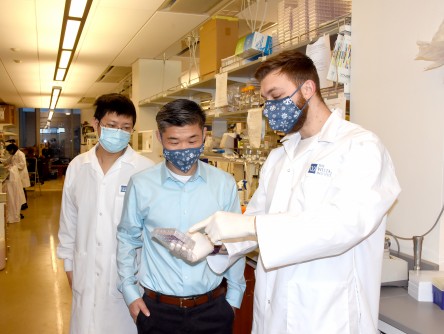By Wistar Institute
Newswise — PHILADELPHIA — (Sept. 21, 2021) — Mutations in the ARID1A gene are present in more than 50% of ovarian clear cell carcinomas (OCCC), for which effective treatments are lacking. Scientists at The Wistar Institute discovered that loss of ARID1A function enhances a cellular stress response pathway that promotes survival of cancer cells, which become sensitive to pharmacological inhibition of this pathway. These findings were published online in Cancer Research, a journal of the American Association for Cancer Research, and point to a new therapeutic opportunity for this type of ovarian cancer for which new solutions are urgently needed.
Inactivating mutations in the ARID1A tumor suppressor gene are genetic drivers of OCCC, which does not respond to chemotherapy and carries the worst prognosis among all subtypes of ovarian cancer.
“The goal of our research is to uncover the molecular changes caused by ARID1A loss so that we can target them specifically to achieve effective therapies for this devastating disease,” said Rugang Zhang, Ph.D., deputy director of The Wistar Institute Cancer Center, professor and leader of the Immunology, Microenvironment & Metastasis Program, and lead author of the study. “In this study, we focused on a stress response mechanism that tumors resort to for survival and found a link that offers a therapeutic opportunity.”
The endoplasmic reticulum (ER) is a cellular structure that oversees protein production and harbors complex mechanisms to respond to the stress caused by accumulation of misfolded proteins. The ER stress response is frequently hyperactivated in cancer cells to favor their survival in stressful microenvironment conditions. Therefore, inhibition of this mechanism has been explored as a therapeutic approach for cancers with hyperactive ER stress response.
The IRE1a/XBP1 pathway is the major signaling pathway involved in the ER stress response. The protein Inositol-required enzyme alpha (IRE1a) senses ER stress and activates the transcription factor X-box binding protein 1 (XBP1), resulting in upregulation of genes that resolve the ER stress and promote cell survival.
Zhang and colleagues found that ARID1A inhibits the IRE1a/XBP1 pathway and, consequently, ARID1A loss in ovarian cancer causes an increased activation of the pathway, creating a dependence of cancer cells on upregulated IRE1a-XBP1. Indeed, treatment of ovarian cancer cells that do not express ARID1A with the selective IRE1a inhibitor B-I09 caused cell death as a result of unresolved ER stress.
“In some cases, the mechanisms cancer cells exploit to their advantage also make them vulnerable because they become dependent on certain pathways,” added Zhang. “If we can find ways to block those pathways, we may be able to use them as weak spots for killing cancer.”
Importantly, this observation was confirmed in vivo, as B-I09 treatment reduced tumor burden and improved survival in mouse models bearing ARID1A-inactivated ovarian tumors.
Therapeutic resistance enables cancer cells to escape the effects of single agent treatments, and combination strategies offer a solution for this major challenge. Therefore, researchers tested the combination of IRE1a inhibition with histone deacetylase 6 (HDAC6) inhibition, which is also effective against ARID1A-mutant cancers. Since HDAC6 regulates the degradation of misfolded proteins, the team hypothesized that the two treatments may act in synergy to suppress ARID1A-mutant cancers.
“Our findings suggest that pharmacological inhibition of the IRE1a/XBP1 pathway of the ER stress response, alone or in combination with HDAC6 inhibition, represents a potential therapeutic strategy for ARID1A-mutated cancers,” said Joseph Zundell, a pre-doctoral trainee in the Zhang lab and first author on the paper.
Co-authors: Takeshi Fukumoto, Jianhuang Lin, Nail Fatkhudinov, Timothy Nacarelli, Andrew V. Kossenkov, Qin Liu, Joel Cassel, and Shuai Wu from The Wistar Institute; Chih-Chi Andrew Hu from Houston Methodist Research Institute.
This article was published by Wistar Institute.


